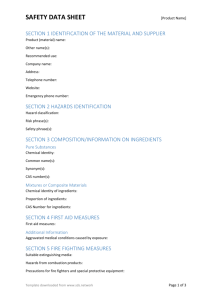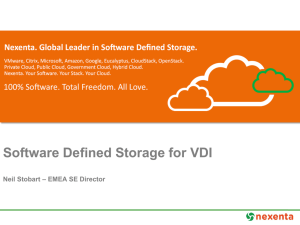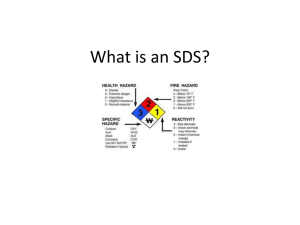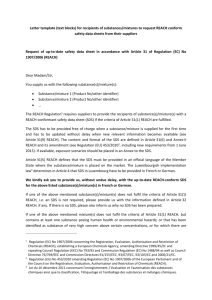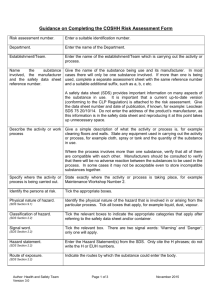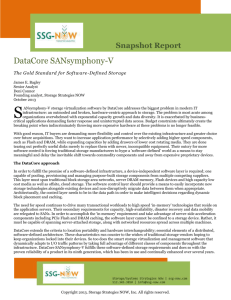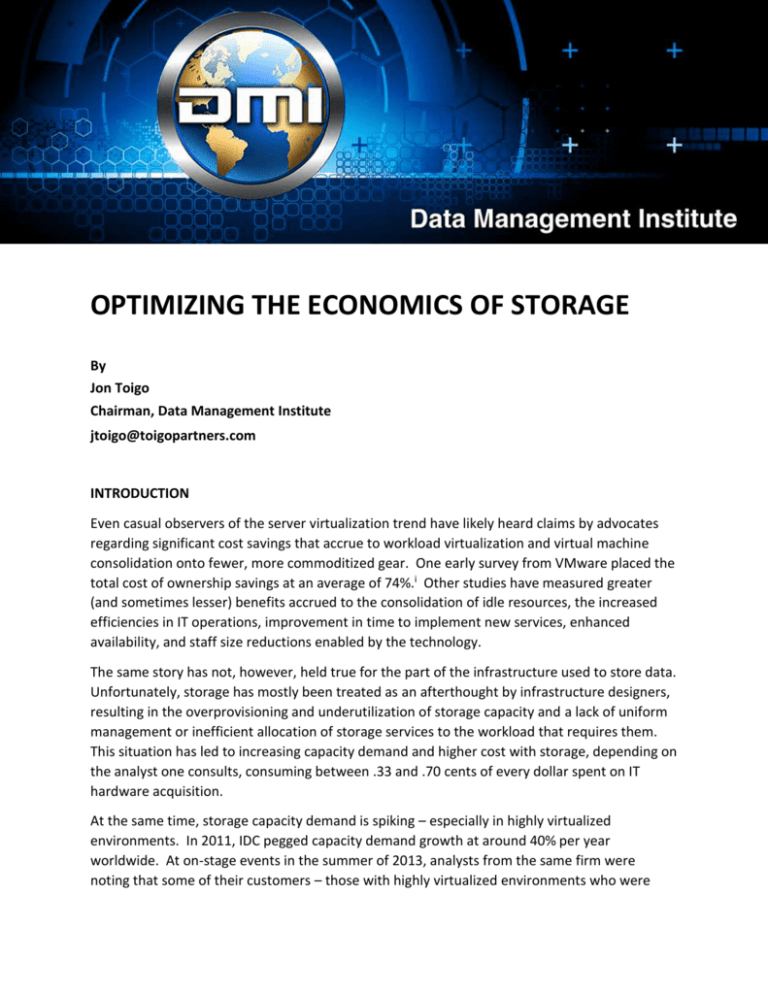
OPTIMIZING THE ECONOMICS OF STORAGE
By
Jon Toigo
Chairman, Data Management Institute
jtoigo@toigopartners.com
INTRODUCTION
Even casual observers of the server virtualization trend have likely heard claims by advocates
regarding significant cost savings that accrue to workload virtualization and virtual machine
consolidation onto fewer, more commoditized gear. One early survey from VMware placed the
total cost of ownership savings at an average of 74%.i Other studies have measured greater
(and sometimes lesser) benefits accrued to the consolidation of idle resources, the increased
efficiencies in IT operations, improvement in time to implement new services, enhanced
availability, and staff size reductions enabled by the technology.
The same story has not, however, held true for the part of the infrastructure used to store data.
Unfortunately, storage has mostly been treated as an afterthought by infrastructure designers,
resulting in the overprovisioning and underutilization of storage capacity and a lack of uniform
management or inefficient allocation of storage services to the workload that requires them.
This situation has led to increasing capacity demand and higher cost with storage, depending on
the analyst one consults, consuming between .33 and .70 cents of every dollar spent on IT
hardware acquisition.
At the same time, storage capacity demand is spiking – especially in highly virtualized
environments. In 2011, IDC pegged capacity demand growth at around 40% per year
worldwide. At on-stage events in the summer of 2013, analysts from the same firm were
noting that some of their customers – those with highly virtualized environments who were
adopting early “hyper-converged infrastructure” models proffered by their preferred hypervisor
vendors -- were actually seeing their storage capacity demand increase year over year by as
much as 300%, driven by the minimum three node storage clustering configurations embodied
in proprietary hyper-converged architecture. Gartner analysts responded by nearly doubling
that estimate to take into account additional copies of data required for archive, data mining
and disaster recovery.
Bottom line: in an era of frugal budgets, storage infrastructure stands out like a nail in search of
a cost reducing hammer. This paper examines storage cost of ownership and seeks to identify
ways to bend the cost-curve without shortchanging applications and their data of the
performance, capacity, availability, and other services they require.
BUILDING STORAGE 101
Selecting the right storage infrastructure for the application infrastructure deployed by a
company requires that several questions be considered. These may include:
Which technology will work with the applications, hypervisors and data that we have
and are producing?
Which technology will enhance application performance?
Which technology will provide greater data availability?
Which technology can be deployed, configured and managed quickly and effectively
using available, on-staff skills?
Which technology will provide greater, if not optimal, storage capacity efficiency?
Which technology will enable storage flexibility; i.e., ability to add capacity or
performance in the future without impacting the applications?
To these questions, business-savvy IT planners will also add another: which technology will fit
with available budget? Truth be told, there are ideal ways to store data that will optimize
performance, preservation, protection and management, but probably far fewer ways that are
cost-efficient or even affordable. Moreover, obtaining budgetary approval for storage
technology is often challenged by the need to educate decision-makers about the nuances of
storage technology itself. While everyone accepts that data needs to be stored and that the
volume of data is growing, some technical knowledge is required to grasp the differences
between various storage products and the benefits they can deliver over a usage interval that
has grown from three years to five (or even seven) years in many organizations.
The simplest approach may seem to be to follow the lead of a trusted vendor. Hypervisor
vendors have proffered many strategies since the early 2000s for optimizing storage I/O. These
strategies, however, have generally proven to have limited longevity. For example, VMware’s
push for industry-wide adoption of its vStorage APIs for Array Integration (VAAI), a technology
intended to improve storage performance by offloading certain storage operations to
OPTIMIZING THE ECONOMICS OF STORAGE
© COPYRIGHT 2015 BY THE DATA MANAGEMENT INSTITUTE, LLC. ALL RIGHTS RESERVED.
2
intelligent hardware controllers on arrays, now seems to have been relegated to the dustbin of
history by the vendor as it pushes a new “hyper-converged storage” model, VSAN, that doesn’t
support VAAI at all.
Indeed, a key challenge for IT planners is to see beyond momentary trends and fads in storage
and to arrive at a strategy that will provide a durable and performant storage solution for the
firm at an acceptable cost. This requires a clear-headed assessment of the components of
storage cost and the alternative ways to deliver storage functionality that optimizes both CAPEX
and OPEX expense.
WHY DOES STORAGE COST SO MUCH?
On its face, storage technology, like server technology, should be subject to commodity pricing.
Year after year the cost of a disk drive has plummeted while the capacity of the drive has
expanded. The latter trend has leveled out recently, according to analysts at Horison
Information Strategies, but the fact remains that the cost per gigabyte of the disk drive has
steadily declined since the mid-1980s.
OPTIMIZING THE ECONOMICS OF STORAGE
© COPYRIGHT 2015 BY THE DATA MANAGEMENT INSTITUTE, LLC. ALL RIGHTS RESERVED.
3
At the same time, the chassis used to create disk arrays, the hardware controllers used to
organize disks into larger sets with RAID or JBOD technologies, and even the RAID software
itself have all become less expensive. However, finished arrays have increased in price by
upwards of 100% per year despite the commoditization of their components.
Part of the explanation has been the addition by hardware vendors of “value-add software” to
array controllers each year. A recent example saw an array comprising 300 1TB disk drives in
commodity shelves (hardware costs totaling about $3,000) being assigned a manufacturer’s
suggested retail price of $410,000 – because the vendor had added de-duplication software to
the array controller.ii Value-add software is used by array makers to differentiate their
products from those of competitors and often adds significant cost to products irrespective of
the actual value added to or realized from the kit.
Ultimately, hardware costs and value-add software licenses, plus leasing costs and other
factors, contribute to acquisition expense, which companies seek to amortize over and
increasingly lengthy useful life. IT planners now routinely buy storage with an eye toward a 5–
to-7 year useful life, up from about 3 years only a decade ago. Interestingly, most storage kits
ship with a three year warranty and maintenance agreement, and re-upping that agreement
when it reaches end of life costs about as much as an entirely new array!
OPTIMIZING THE ECONOMICS OF STORAGE
© COPYRIGHT 2015 BY THE DATA MANAGEMENT INSTITUTE, LLC. ALL RIGHTS RESERVED.
4
But hardware acquisition expense is only
about a fifth of the estimated annual cost
of ownership in storage, according to
leading analysts. Cost to acquire (CAPEX)
is dwarfed by the cost to own, operate and
manage (OPEX).
IT planners now routinely buy storage with an eye
toward a 5–to-7 year useful life, up from about 3
years only a decade ago. Interestingly, most storage
kits ship with a three year warranty and
maintenance agreement, and re-upping that
agreement when it reaches end of life costs about as
much as an entirely new array!
Source: Multiple storage cost of ownership studies from Gartner, Forrester, and Clipper Group
Per the preceding illustration, Gartner and other analysts suggest that management costs are
the real driver of storage total cost of ownership. More specifically, many suggest that
heterogeneity in storage infrastructure, which increases the difficulties associated with unified
management, is a significant cost accelerator. While these arguments may hold some validity,
they do not justify the replacement of heterogeneous storage platforms for a homogeneous set
of gear. As discussed later, heterogeneous infrastructure emerges in most data centers as a
function of deliberate choice – to leverage a new, best-of-breed technology or to facilitate
OPTIMIZING THE ECONOMICS OF STORAGE
© COPYRIGHT 2015 BY THE DATA MANAGEMENT INSTITUTE, LLC. ALL RIGHTS RESERVED.
5
storage tiering. Truth be told, few, if any, hardware vendors have diversified enough product
offerings to meet the varying storage needs of different workloads and data. Those that have a
variety of storage goods typically do not offer common management across all wares, especially
when some kits have become part of the vendor’s product line as the result of technology
acquisitions.
From a simplified standpoint, the annual cost of ownership of storage can be calculated as
follows:
In truth, expense manifests itself in terms of capacity allocation efficiency (CAE) and capacity
utilization efficiency (CUE). Allocation efficiency is a measure of how efficiently storage
capacity is allocated to data. Utilization efficiency refers to the placement of the right data on
the right storage based on factors such as re-reference frequency.
Businesses tend to purchase and deploy capacity in a sub-optimal manner, purchasing “tier
one” storage to host the data from applications that do not require the expensive high
performance attributes of the kit. Moreover, the movement to “flatten” storage infrastructure
represented by Hadoop and many of the “hyper-converged” storage models is eliminating the
benefits of tiered storage altogether. Tiered storage is supposed to enable the placement of
data on performance/capacity/cost-appropriate storage infrastructure, reducing the overall
cost of storage. The best mix for most firms is fairly well understood.
OPTIMIZING THE ECONOMICS OF STORAGE
© COPYRIGHT 2015 BY THE DATA MANAGEMENT INSTITUTE, LLC. ALL RIGHTS RESERVED.
6
Horison information Strategies and other analysts have identified the traditional tiers of storage
technology and the optimal percentages of business data that tend to occupy each tier.
Ignoring storage tiering and failing to place data on access-appropriate tiers is a huge cost of
ownership accelerator. Using the recommended percentages and storage cost-per-GB
estimates in the chart above, building a 100 TB storage complex using only Tier 1 and 2 storage
(all disk) will cost approximately $765,000. The same storage complex, with data segregated
using the ratios described in the preceding model, would cost approximately $482,250. iii
Failure to leverage the benefits of Hierarchical
Storage Management (HSM), which is the basic
technology for moving data around
infrastructure based on access frequency, update
frequency and other criteria, has shown up in
dramatically poor utilization efficiency in most
data centers today. A study of nearly 3000
storage environments performed in 2010 by the
Data Management Institute found that an
average of nearly 70% of the space of every disk
drive in a firm was being wasted – either
allocated, forgotten and unused, or storing
never-referenced data, data with no owner in
metadata, or contraband.
The argument could be made that a significant
amount of storage capacity could be recovered
OPTIMIZING THE ECONOMICS OF STORAGE
© COPYRIGHT 2015 BY THE DATA MANAGEMENT INSTITUTE, LLC. ALL RIGHTS RESERVED.
7
and put to better use if companies would practice better storage management, data hygiene,
and archive. That would effectively reduce storage cost of ownership by lessening the amount
of new capacity a company would need to acquire and deploy year over year. Instead, most of
the attention in storage technology has been placed lately on new storage topologies that are
intended, nominally at least, to drive cost out of storage by reducing kit down to its commodity
parts and removing value-add software from the controllers of individual arrays and placing it
into a common storage software layer: so-called “software-defined storage” (SDS).
Software-defined Storage, in theory, enables the common management of storage by removing
barriers to service interoperability, data migration, etc. that exist in proprietary, branded
arrays. Currently, storage arrays from different manufacturers, and even different models of
storage arrays from the same manufacturer, create isolated islands of storage capacity that are
difficult to share or to manage coherently. Standards-based efforts to develop common
management schemes that transcend vendor barriers, including the SNIA’s SMI-S protocol and
the World Wide Web Consortium’s REST, have met with limited adoption by the industry,
leading Forrester and other analysts to insist that only by deploying homogeneous storage (all
equipment from one vendor) can the OPEX costs of storage be managed.
SOFTWARE-DEFINED STORAGE TO THE RESCUE?
Software-defined Storage, while it holds out some hope for surmounting the problems of
hardware proprietary-ness, has in some cases been hijacked by hypervisor vendors, who seek
to portray their hyper-converged infrastructure offerings as a kind of “open” SDS. In fact,
hypervisor-specific storage models have done little more than institute a new “isolated island of
technology” problem. Each of the leading hypervisor software vendors has its own game plan
with respect to hyper-converged and its own proprietary technology that produces an
infrastructure that can only be used to store data from that hypervisor. VSAN from VMware
will only store the data from workload virtualized with VMware. Microsoft’s clustered storage
spaces SDS model is intended for use only with Hyper-V workload, though the company
provides a conversion utility that will convert a VMware VMDK file into a Hyper-V VHD file if the
customer wants to use the storage space managed by the Hyper-V SDS utility to store “alien”
workload.
Of course, the SDS model is not a standard and there are many takes on the design and
function of this software stack. Third party developers and ISVs have taken the initiative to
improve upon the concepts and architecture articulated by leading hypervisor vendors to make
SDS more robust and affordable. These improvements include:
The implementation of SDS using “bare bones” hardware in a direct attached
configuration: no more complex switched fabric or LAN-attached storage to deal with,
no more proprietary storage gear
OPTIMIZING THE ECONOMICS OF STORAGE
© COPYRIGHT 2015 BY THE DATA MANAGEMENT INSTITUTE, LLC. ALL RIGHTS RESERVED.
8
The abstraction of value-add functions away from array controller, placed in server
software layer: no more proprietary software licenses and firmware levels to be
concerned about; storage services can be applied to all capacity, not just media
“trapped” behind a specific hardware array controller
Ease of storage service management via a unified user interface: no searching for third
party tools or array-specific element managers to monitor or administer storage
infrastructure
These attributes, while potentially improving on the problems with legacy storage
infrastructure, do not address all of the challenges that make storage so expensive to own and
operate. While a robust software-defined storage solution may remove barriers to “federated”
management and improve the agility with which storage services (like mirroring, continuous
data protection, de-duplication, etc.) can be applied to specific infrastructure and assigned to
specific workload, most SDS solutions do nothing whatsoever to aid in the management of the
existing storage resource – or of storage capacity generally. In fact, some SDS evangelists argue
that capacity management should remain the domain of the hardware array controller –
though a compelling explanation as to why is never offered. Truth be told, by excluding
capacity management from the list of functions provided by the software-defined storage layer,
the sharing of capacity to support workload data from virtual machines running under different
hypervisor brands (or workloads running without any sort of virtualization at all) is very
problematic. This leads to a problem of storage stove-piping and increases management
complexity and cost.
The good news is that some thought leaders in the SDS space are seeking to manage not only
services, but capacity, in a more comprehensive, infrastructure-wide manner. Such an
approach is evolving in the SDS offerings of IBM with its Spectrum Virtualize offering, but it is
already available from DataCore Software.
STORAGE VIRTUALIZATION ENHANCES SDS AND REDUCES TCO
Just as server virtualization was introduced into the server world to improve the cost-metrics
and allocation/utilization efficiencies of server kit, so too storage virtualization can be leveraged
to make the most out of storage infrastructure while reducing cost of ownership. This begins
with storage acquisition costs.
In a virtualized storage environment, all storage – whether direct attached or SAN attached (socalled legacy storage) – can be included in a storage resource pool. This eliminates the need to
“rip and replace” infrastructure in order to adopt an “isolated island” hyper-converged storage
model and the costs associated with infrastructure replacement.
A virtualized storage environment reduces CAPEX and OPEX. Storage can be divided into virtual
pools, each comprising a different set of characteristics and services. A tier one pool may be
OPTIMIZING THE ECONOMICS OF STORAGE
© COPYRIGHT 2015 BY THE DATA MANAGEMENT INSTITUTE, LLC. ALL RIGHTS RESERVED.
9
optimized for performance, while a tier zero pool may be comprised completely of silicon.
Similarly, high capacity, low cost, low performance disks may be fashioned into a pool intended
for the lion’s share of data that evidences infrequent access or update. So, virtualized storage
enables the implementation of HSM and other processes that have the effect of improving
capacity utilization efficiency.
As for capacity allocation efficiency, virtualized storage provides the means for managing
capacity and for allocating it to workload -- and for scaling it over time -- in an agile way.
Technologies such as thin provisioning, compression and de-duplication can be applied across
entire infrastructure, rather than isolated behind specific hardware controllers, to help capacity
to be used more efficiently. This in turn can slow the rate at which new capacity must be added
and enables less expensive, and even used, equipment to be added to the pool. Centralizing
this functionality for ease of administration and allocation may also reduce the costs associated
with software maintenance and renewal fees, which are currently misunderstood by many IT
planners, according to Amazon Web Services and others. According to AWS, an important, yet
under-disclosed rationale for adding cloud storage to the storage infrastructure in a company is
to reduce storage software maintenance and renewal costs.iv
There are many approaches to virtualizing storage capacity, from establishing a hardware
controller to which all storage attaches, to virtualizing the connection or mount points where
storage connects to a server and its operating system. DataCore was an early innovator in
mount point virtualization, so any storage that can be connected to a Microsoft OS server can
be seen, used and virtualized by DataCore Software-Defined Storage platform.
Virtualizing capacity builds on the SDS model by placing under centralized control and
management, the configuration and allocation of physical storage infrastructure as virtual
storage pools. Additionally, DataCore uses DRAM on devices in its virtualized infrastructure to
create a unified cache across servers that can be used to buffer and accelerate applications.
Moreover, DataCore’s SDS solution virtualizes the “plumbing” – the I/O pathways and channels
between storage devices and the server – and load balances across these connections to deliver
consistently the best possible interconnect performance between server and storage. These
are all advantages of storage virtualization that can contribute to making SDS a truly effective
driver of better storage at a lower cost.
The rest of the traditional use case for SDS involves the delivery of storage services to the
storage shares. This was the original intent of SDS, to abstract storage services away from
hardware controllers and place them in a software layer that could be used across all storage
infrastructure. With DataCore, these services are of four types: performance, availability,
management and efficiency.
OPTIMIZING THE ECONOMICS OF STORAGE
© COPYRIGHT 2015 BY THE DATA MANAGEMENT INSTITUTE, LLC. ALL RIGHTS RESERVED.
10
Source: DataCore Software
Efficiency and performance refer to processes and tools for accomplishing the objectives
already discussed: to wrangle all physical storage, memories and interconnects into a
comprehensive resource infrastructure that can be allocated and de-allocated, scaled and
managed readily. Performance involves the movement of data between tiers, the inclusion of
specific data in clearly defined data preservation and archive schemes and the migration of data
between volumes or pools. All of these activities, which can be time-consuming and expensive
in a heterogeneous equipment setting are simplified in a virtualized storage environment,
thereby saving operator time and potentially the need to purchase specialized software for
data migration, etc.
Availability involves the allocation of special services like mirroring and replication, failover and
failback, and Continuous Data Protection (CDP) to workload that requires them. This can be
done in a wizard-based way when a virtual volume is carved out from a pool for use as a
repository for a specific workload and its data. The ability to associate specific data protection
services with specific workload has a tendency to reduce the cost of data protection overall by
custom-fitting the right services to the right data.
In the diagram, the block marked Management comprises additional functionality designed to
facilitate the integration of the DataCore infrastructure with NAS and cloud storage, and to
enable the federated management of multiple DataCore infrastructure installations, all under
one management console. That provides all of the controls, processes and tools required to
drive down OPEX (which is the majority of cost) by making a heterogeneous storage
environment as simple to manage as a homogenous environment. This is “true” SDS.
OPTIMIZING THE ECONOMICS OF STORAGE
© COPYRIGHT 2015 BY THE DATA MANAGEMENT INSTITUTE, LLC. ALL RIGHTS RESERVED.
11
CHECKLIST FOR BUYERS
From the preceding discussion, it should be clear that bending the cost curve in storage
requires a clear-headed assessment of options. As a general rule, CAPEX cost reductions derive
from the reduction of proprietary hardware kit and the implementation of technology that will
enable unified management of the myriad moving parts of a storage infrastructure. Virtualizing
storage is less expensive than simply ripping and replacing on kit for another.
OPEX cost reductions usually derive from managing the allocation of capacity in a more agile
way, managing the utilization of capacity in a more automated way, and managing all
infrastructure in a unified way, supported by wizards, etc. With the right software-defined
storage solution, especially one that includes storage virtualization technology, applying the
right software services to infrastructure is a much easier process.
Here is a list of additional items that should be on your buyer’s checklist when evaluating SDS
offerings with an eye toward reducing storage TCO:
Support for currently deployed infrastructure
Support for planned hardware technology acquisitions
Viable application I/O acceleration technology that works with server infrastructure for
improved performance
Ease of installation
Ease of storage capacity allocation
Ease of storage service allocation
Effective capacity efficiency (e.g. Compression, De-Duplication) capabilities
Mirroring/replication service without hardware constraints
Data migration between different virtual storage pools without hardware constraints
Common management of centralized and distributed storage components
Failover/Fail Back capabilities
Automatic I/O re-routing
OPTIMIZING THE ECONOMICS OF STORAGE
© COPYRIGHT 2015 BY THE DATA MANAGEMENT INSTITUTE, LLC. ALL RIGHTS RESERVED.
12
ENDNOTES
i
Reducing Server Total Cost of Ownership with VMware Virtualization Software, VMware Inc., Palo Alto, CA,
2/13/2006, p. 3.
ii
This reference is to an early model of the Data Domain de-duplicating storage appliance, circa 2010. The unit
featured 300 1TB SATA drives with a RAID 6 controller and commodity drive shelves and array enclosure.
Estimated hardware costs were approximately $3000 to $4000. The addition of de-duplication software, which the
vendor suggested would provide a 70:1 reduction ratio, contributed to a $410,000 MSRP.
iii
100TB of storage deployed at a cost of $50-$100 per GB for flash (1-3% as tier 0), plus $7-$20 per GB for fast disk
(12-20% as tier1), plus $1 to $8 per GB for capacity disk (20-25% as tier 3), plus $.20 - $2 per GB for low
performance, high capacity storage (40-60% as tier 4) totals approximately $482,250. Splitting the same capacity
between only tier 1 and tier 2 at the estimated cost range per GB for each type of storage yields an estimated
infrastructure acquisition cost of $765,000.
iv
See http://www.slideshare.net/AmazonWebServices/optimizing-total-cost-of-ownership-for-the-aws-cloud36852296
OPTIMIZING THE ECONOMICS OF STORAGE
© COPYRIGHT 2015 BY THE DATA MANAGEMENT INSTITUTE, LLC. ALL RIGHTS RESERVED.
13



